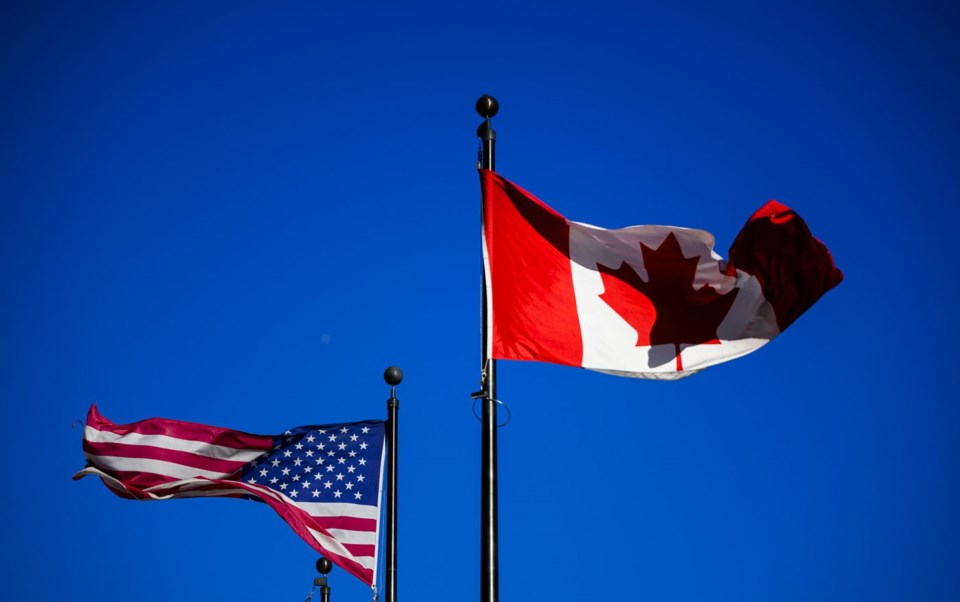OTTAWA — Canadian exporters did more business with the United States in June even as tariffs ramped up, Statistics Canada said Tuesday.
The agency said exports to the U.S. rose 3.1 per cent in June compared with the prior month, but were still down 12.5 per cent on a year-over-year basis.
Canada's trade surplus with the U.S. expanded to $3.9 billion in June from $3.6 billion in May as imports rose less than exports.
Overall, Canada's merchandise trade deficit with the world widened to $5.9 billion in June, up from $5.5 billion in May.
The June figures close a volatile first half of the year that saw on-again, off-again tariffs from the United States skew Canadian trade volumes.
StatCan said total exports were up modestly for the second month in a row in June, coming off the biggest drop in nearly five years in April as early tariffs took full effect. Higher energy exports were largely to thank for the increase.
The agency said there was a June jump in imports tied to a one-time, high-value shipment — an offshore oil project module from the United States bound for Newfoundland.
That import surge was somewhat offset by Canadian firms getting higher prices for their exports, the agency said. By volume, exports were down in the month.
CIBC senior economist Andrew Grantham said in a note to clients Tuesday that while two-way trade picked up in June, the latest figures show "Canadian trade still hasn't found a new footing."
"While trade flows should stabilize in the months ahead, their level will likely remain lower than that seen last year due to ongoing U.S. tariff policy and related uncertainty," Grantham said.
A decrease in metal and mineral product exports, meanwhile, was driven by declines in shipments of unwrought gold to the United Kingdom, StatCan said.
Declines in metals exports also coincided with the U.S. doubling global steel and aluminum tariffs to 50 per cent early in June, the agency said.
Exports of unwrought aluminum and iron and steel products were down more than 11 per cent in the month, while exports of motor vehicle parts dropped 4.2 per cent.
Tariffs and the threats of steep duties from the United States have distorted Canada's trade figures through the first half of the year.
StatCan said total exports were up 2.2 per cent in the first six months of 2025 compared to the same stretch in 2024.
After exports hit a record high in the first quarter — economists believe firms were moving up activity to get ahead of tariffs coming into effect in March and April — StatCan said total exports fell 12.8 per cent in the second quarter.
Canada's quarterly merchandise trade deficit hit a record $19 billion in the second quarter of the year, up from $388 million in the first quarter.
Nathan Janzen, assistant chief economist at RBC, said in a note that Canadian export volumes fell 31.4 per cent on an annualized rate in the second quarter of 2025.
"A plunge in Q2 Canadian export volumes is on track to substantially subtract from Canadian GDP in Q2 following a pre-tariff surge in Q1 when U.S. importers rushed to front-run tariffs," Janzen said.
StatCan said exports to countries other than the U.S. declined in June, coming down from a record high in May and marking the first decrease in the category since February.
The June figures won't capture any impact from U.S. President Donald Trump's recent move to impose 35 per cent tariffs on Canadian imports, as well as 50 per cent global tariffs on semi-finished copper, starting Aug. 1.
But because the latest tariffs will continue to exempt Canadian goods compliant with the Canada-U.S.-Mexico Agreement on trade, RBC expects the higher duties will only apply to roughly six per cent of goods crossing the border.
"We continue to expect that current rules, if maintained as currently in place, would leave Canada with the lowest tariff rate of any major U.S. trade partner — putting Canadian exporters in a stronger relative position to compete for U.S. import market share than other countries," Janzen wrote.
In a separate release, StatCan said monthly services exports rose one per cent to $18 billion in June.
Taking into account goods and services, the agency said Canada's total trade deficit with the world rose to $6.5 billion in June, up from $6.4 billion the month previous.
This report by The Canadian Press was first published Aug. 5, 2025.
Craig Lord, The Canadian Press



